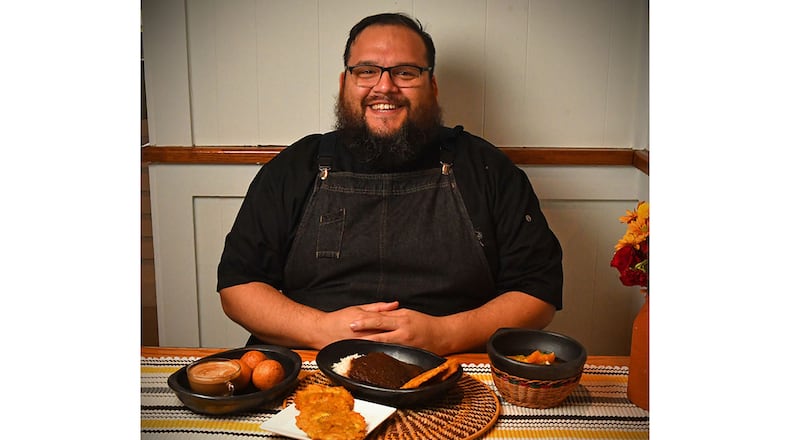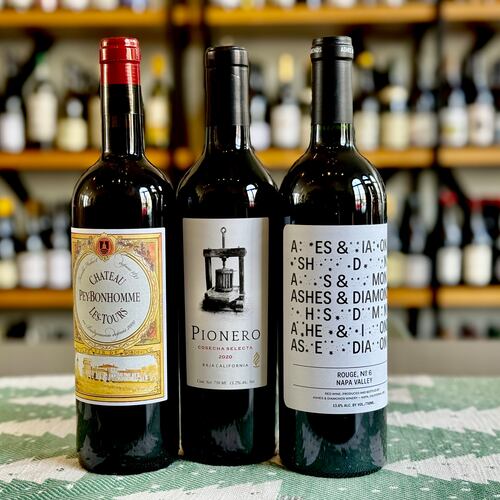This New Year’s Eve, Christian Lopez of Latin American pop-up and catering business Humo Cuisine will be in Los Angeles serving a traditional Colombian beef dish, Posta Negra Cartagenera, to family living there.
A second-generation Colombian American, Lopez had never eaten this dish until he was in Cartagena almost seven years ago on his honeymoon. He was intrigued by its connection to New Year’s celebrations. “New Year’s Eve is a big holiday in Colombia and, as in many cultures, serving a roast is the sign of a special meal. The new year brings lots of other traditions, too. Many people pack a suitcase and at midnight go to a neighbor’s house with their luggage to ensure travel in the new year. Or eat one grape for each of the coming 12 months so they’ll have a year’s worth of good luck.”
Credit: CHRIS HUNT
Credit: CHRIS HUNT
Lopez was born in the States and grew up in this country, and his Colombian maternal grandmother, Maria Lucy Castro, was the cook in the family. “She cooked the food she grew up with, so we ate a lot of rice and beans, arepas and sancocho, a chicken stew with potatoes and cassava. If we had beef, it was usually some sort of ground beef.”
Lopez attended culinary school after graduating from high school, but went on to earn an education degree and now teaches math at Peachtree Middle School in Dunwoody.
“It wasn’t until I moved to Atlanta and traveled to Colombia as an adult that I began researching the food of Colombia and I learned about dishes like Posta Negra and Lechona (slow-cooked whole pork stuffed with rice, peas and spices) and using maíz trillado (dried hominy) to make empanadas, tamales and arepas,” Lopez said.
In October 2021, his wife, JoJasmin, encouraged him to open Humo Cuisine as a pop-up, in part as a response to the pandemic and wanting to connect more directly with his roots and also because Colombian food isn’t widely available in the Atlanta area. He still holds pop-ups but now focuses more on large-scale events and catering.
“I enjoy feeding people and always wanted to do something with food. I named the business ‘humo’ because that means ‘smoke’ in Spanish and I wanted to marry Latin flavors and the technique of smoking. I make the very best pernil, a smoked pork shoulder, and I also make Colombian-style shrimp ceviche and Colombian empanadas, very different from other empanadas you find in Atlanta.”
RECIPES
Atlanta chef Christian Lopez of Humo Cuisine shares recipes for a New Year’s Eve dinner in the style of his family’s native Colombia.
Credit: CHRIS HUNT
Credit: CHRIS HUNT
Chuyaco (Colombian Orange Salad)
This dish originates in Valle del Cauca, a department on Colombia’s Pacific coast. “Oranges are probably my favorite fruit and I love the combination of the sweetness of the fruit with the hint of umami from the green onions. It’s so simple and it’s so good,” said Lopez. He suggests serving this as a first course.
About the ingredients: The salad can be made with one variety or a mix of navel, Valencia or blood oranges, or the red-fleshed Cara Cara navel oranges that were first found in Venezuela. Panela, also called piloncillo, is unrefined cane sugar molded into cakes or loaves traditionally used in Latin cooking and is available at stores that stock Latin groceries. Dark brown sugar can be substituted.
Note: For nutritional calculations, salt was calculated as 1/16 teaspoon.
Credit: CHRIS HUNT
Credit: CHRIS HUNT
Posta Negra Cartagenera (Colombian-Style Black Beef)
This dish takes its name from Cartagena, a city on Colombia’s Caribbean Sea coast, and its flavors are influenced by the mix of Spanish and African people who settled there.
“Although Colombians eat a lot of beef, this is not a dish my grandma cooked for us. It’s traditionally served with coconut rice but that’s on the sweeter side, and since the sauce for the roast is already sweet, I like it better with jasmine rice,” said Lopez.
About the ingredients: Adobo seasoning is generally a mix of salt, cumin, garlic, pepper, oregano and turmeric, available in the spice aisle of most grocery stores or in the international food section. Lopez substitutes sweet lunchbox peppers for the small sweet peppers called “ajito topito” along the Caribbean coast and “aji dulce” in other Latin cultures.
Note: For nutritional calculations, salt was calculated as 1/16 teaspoon.
Credit: CHRIS HUNT
Credit: CHRIS HUNT
Fried Green Plantains (Patacones)
In other Latin cultures, these twice-fried plantains are called “tostones.”
Twice frying the plantains results in a very crisp exterior and a tender interior to each patacon, and the starchy flavor serves as a counterpoint to the rich, sweet sauce of the Posta Negra Cartagenera.
Credit: CHRIS HUNT
Credit: CHRIS HUNT
Colombian Buñuelos
Buñuelos are a traditional Colombian treat, sold at every corner bakery. Lopez says his family didn’t make their own, but would buy them at a bakery and serve them at home with coffee or his grandmother’s hot chocolate. “We’d eat them for breakfast or as a snack, and they’re definitely better when they’re hot.”
About the ingredients: Tapioca starch is available at natural food stores or in the gluten-free flour section of some grocery stores. Cotija, available with other Latin cheeses at most grocery stores, can be purchased pre-grated or in disks.
Sign up for the AJC Food and Dining Newsletter
Read more stories like this by liking Atlanta Restaurant Scene on Facebook, following @ATLDiningNews on Twitter and @ajcdining on Instagram.
About the Author
The Latest
Featured







